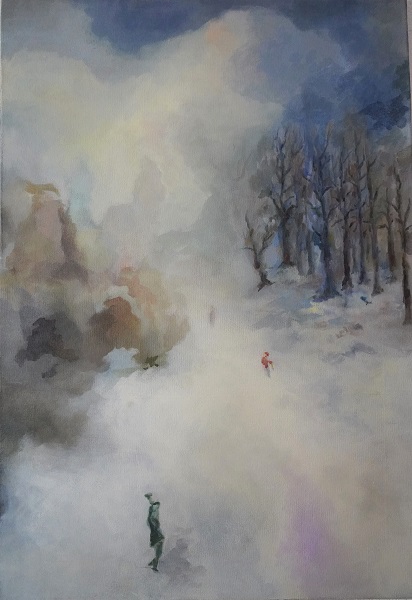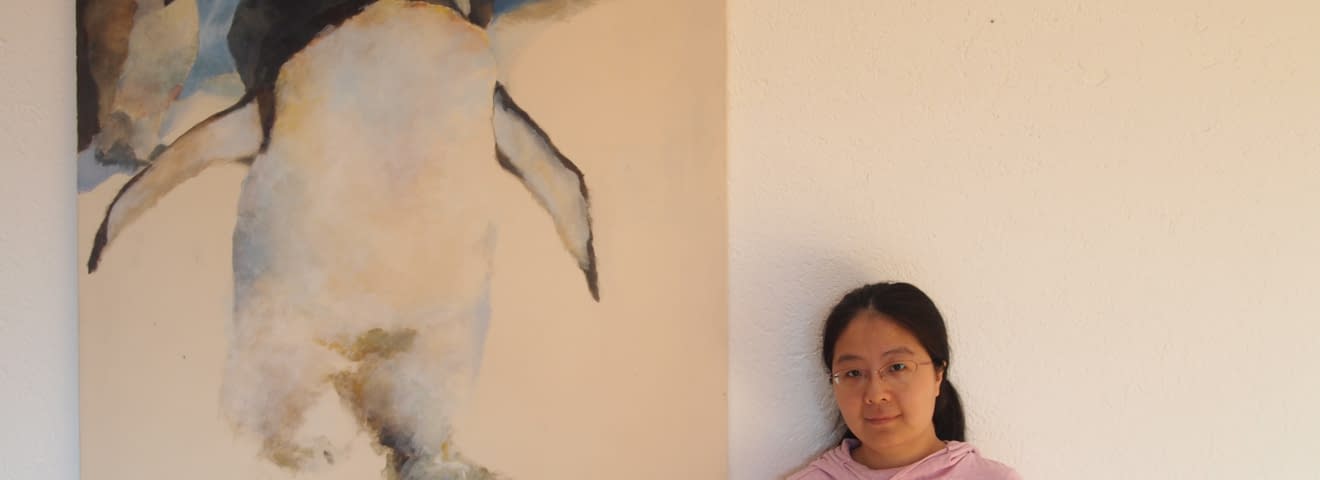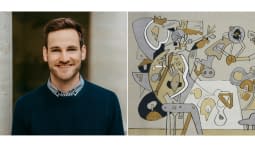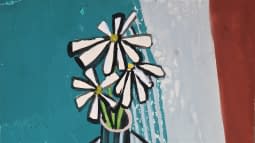Artist Interview with Jiliang Zhang (Liang)
YR: Hello Jiliang. So nice of you to talk to us about your art. I would like to discuss the works in your series «awake and dreaming», which you show on art24. But before we start with the first question about the series, I wanted to ask you what you think of art24?
JZ: Thank you. In my view, art24 is a free platform. Free means, on the one hand, that each person can freely share their own artistic explorations or current experiences through painting; on the other hand, art24 enables each person to find a corresponding work out of this large «collection» of artworks that matches their own state of mind or even spiritual state. In this way, both sides of the participants are given a space, creating a bridge between people.
YR: Turning to your series of works, it seems that your paintings are always on the lookout for this connection between perception/phenomenology and a certain, almost magical feeling. What is this feeling? The title of your series «awake and dreaming» refers to the phenomena of sleeping and being awake. What role do these play in connection with perception and this particular feeling?
JZ: When I say «I feel», I am in a state of dreaming at that very moment. Because when you feel yourself, you are inside yourself. After one has emerged from it, one can only «think» about this feeling, but no longer «feel» it. «To feel» means that one is in a state, as when one is wrapped up in music, for example. In it, one still has a degree of consciousness and is able to express some feelings of it, but not completely. To represent this ineffable, one could perhaps say, is a skill of writers and artists. In this process of representation, clear perception is important. The artist must know which elements and their interaction can evoke/enhance/diminish a certain feeling. This enables the viewer to experience a feeling with the help of the artist's eyes.
YR: Your paintings remind me of a state of the absent-mindedness through which a self-forgetful body-consciousness occurs. It then seems that a tension arises between this absence and this passive consciousness. So, could it also be said that being awake can be experienced as dreamlike? Or to put it another way. Is absence of mind a dreamlike state that remains in our memory precisely because we perceive it through the body?
JZ: Do you mean the paintings in the series of the « Wanderer » (GER. «Wandernden»)? (The series includes the works «On the Way I», «While Waiting», «The Wanderer», «In Spring» (GER. «Auf dem Weg I», «Beim Warten», «Die Wandernde», «Im Frühling»)
YR: Yes, for example, or the painting «While Waiting».
JZ: I think that's an interesting question, whether one can still perceive one's own body under the absence of mind, and if so, to what extent. We could assume that every human being has a mind that can perceive everything from within. This also imprints the feeling of absent-mindedness in itself and thus the physical state, the emotions, the sudden thoughts that arise, the actions of the people around us, and so on. If we want, we can try to invite our mind before the inner eye to ask it. I have had such feelings/imaginings since childhood, as if I have another eye floating in the air looking at all my states of mind and my visible, physical position. This feeling has offered me countless vague images without contour lines, in which I myself am sometimes present like a third person. In Chinese, absent-mindedness can be translated as «the heart/mind is not there». If the spirit is thus not there, not in the «here and now», where is it? That is where the individual and the personal stories are hiding.
YR: I often recognise the motif of travelling or standing still in your pictures. How are perception and movement connected for you? And are these transitions fluid?
JZ: When you are on a tram or a train, it becomes difficult to «do» anything. Even if you concentrate on your work in a moving train, you always have to keep some part of your attention, because otherwise you will miss your stop. In this lack of action, however, the inner movement begins, whether consciously or unconsciously.
YR: What does «rhythm» mean to you in this context?
JZ: For me, «rhythm» is more a concept of colouring. Beyond that, rhythm for me is also the continuation and stopping of the wagon, or the alternation between half-sleep and sudden awakening.
YR: What role do movement and rhythm play in sleep or half-sleep, or in dreams or lucid dreams? For example, in your works «While Waiting», «On the Way I» or «In Spring» (GER: «Am Warten», «Auf dem Weg I», «Im Frühling»)?
JZ: From what I remember, it's hard to fall asleep on a night train. In this so-called «green-skinned train», I could constantly feel the bouncing of the train as it continued to move forward, even when I wasn't looking out through the window. On the one hand, these traces of movement – while the body is still – act as a «background», serving to help us sleep, or help us reach an unconscious state; on the other hand, this jolting makes it impossible for us to concentrate on anything. It is a mysterious experience: because with this rhythmicised mood in the background, part of the consciousness is asleep. As a result, the feelings and memories are freed, they go back into the memories or flow over into another world – like the continuing train carriage! The continuously changing scenery outside has a similar effect, but here through the medium of the visual senses. During a short journey, this dreamlike state also appears, only that the situation is somewhat different, since one only enters this state of half-sleep or lucidity for a short time and does not enter into a deep sleep.
YR: Can you talk about the connection between being alone and being among other people in your paintings? For example, in the pictures «While Waiting» or «On the Way I (Sleeping Train in China)». Does that also have something to do with silence?
JZ: When you are on your path of life, parents, teachers and friends can give many different forms of support, but you have to go through your journey step by step on your own. In this sense, each person is actually alone. Something similar happens in states of mind and spiritual states. People can understand each other, even empathise, but there is almost no one who can completely cover or enfold the feeling of the other. Everyone has their own story and from this individual story each person develops their own way of feeling and thinking... This may sound sad, but this is where the individual and the irreplaceability of each person is rooted. And, when a human being is alone, in the sense that he is fully automatically absorbed in his self, his complex story drifts in the form of a state of mind in the air within him and around him. When this person is among many people, this inner «being alone» is intensified.
YR: The world and our existence hold many secrets, for example, that we can dismiss thinking in dreams. Does this mystery inspire you to make art? If so, could you explain?
JZ: Yes, some secrets push me to want to express them. But I would rather say it's the other way round. A strong feeling overcomes me and then I try to paint it. In this process I feel the mystery, because I have to look inside myself again and again in order to perceive this feeling more clearly. In the process, I find out which events or situations in the scene evoke the particular feeling.
YR: We have already heard a lot about perception. In this context, I wanted to ask you what meaning sounds have in your art?
JZ: That's an interesting question because the sounds of, for example, a train are deeply rooted in my memory. Although I have never thought of specifically depicting this mood, the rhythmic speed of the train, for example, is part of the feeling of «moving forward». Therefore, every time I try to revive my memory, I have to immerse myself in this mood of the sounds.
YR: What kind of topics are on your mind at the moment?
JZ: I have some «longer to process subjects», such as, reflections, blue light, isolation... I usually do research sketches now and if the aspiration is strong enough, I use these researches in the paintings.
YR: Jiliang, thank you very much for your time and trust in art24. We are excited and look forward to what else you will show us with your art in the future.
Picture description by Yvonne Roos: «From a Distance» (GER: «Aus der Ferne», Oil, 55 x 80 cm, January 2017), painted by Jiliang Zhang (Liang)

Areas of colour running diffusely into one another create the impression of a blurred winter landscape with a snow-covered path that disappears into the distance. Bright to almost glaring colours dominate the image. A white mass extends from the lower edge of the picture to the upper half of the picture. The white creates a mysterious, lonely silence and mesmerizes the viewer. By looking at the picture intensively, this silence suddenly seems to be present and to intervene in one's own «real» world. The fresh winter air is literally palpable. At the top edge of the picture, the white mass slowly fades into a blue, revealing the sky that fills the right-hand corner of the picture. Directly below, a group of trees with regular, bare branches emerges. The trees stretch straight upwards, reaching into the sky. Shadowy outlines of other trees can be seen behind the trees, indicating the indefinable size of the forest section. The blue sky shimmers through sometimes and allows the viewer to assume its unknown expanse. This makes the group of trees both threatening and opaque as well as mysterious and mystical.
The white seems to be slowly approaching the group of trees, moving further and further into the nature world to block our view. A vague, greyish-brown outline shimmers through on the left-hand side of the picture. Possibly a rock formation falling into the path like an avalanche. It remains unclear whether these are actually rocks obscured by this white materia, or whether the surface belongs to the white substance. This indeterminacy directs the viewer's gaze to the lower field of the picture. There, the outlines of an anonymous, walking figure can be seen, whose body casts a gentle shadow on the white ground. The person's clothing confirms the impression of a winter landscape. The snow-covered path on which the person is walking meanders between the group of trees and the indeterminable brown area. Between these two pictorial elements there is a second walking figure, which stands out from the white ground because of its red clothing. The gaze continues to follow the snow-covered path and in the distance discovers the soft outlines of a third person in the distance, who disappears more and more into this mass of snow, light and mist – as if being swallowed up by it.
Where does this indefinite path, whose course is denied us, lead? Where do the people find themselves in the painting? What is to be discovered behind this white mass that spreads across the entire landscape? The perspectives, at first comprehensible and logical, seem to dissolve in the next moment. What is snow and what is haze or fog? How big is the forest and what is behind it? The application of colour also emphasises the two-dimensionality of the picture, only to be negated again at the same moment by the shading and depth of the picture. Is it an illusion or is it a real world? The daylight, which is reflected in the snow in the form of yellowish, violet areas, is swallowed up again in the next moment by the grey and brown areas.
So, is it a real landscape, a dream or, like the different landscape elements and states of nature in the picture, do the realities mix together? Where does the dream begin and what belongs to «real» perception? And where does the picture/image begin and where does our actual perception begin? Can these levels be separated from each other at all? What's behind that white wall? It seems to both limit everything and leave all possibilities open. It could serve as a placeholder for different kinds of perception and thus connect them with each other. As a result, the perceptual worlds between dream and waking state, between the pictorial level and reality suddenly appear coherent and inseparable. Forms create themselves interdependently, but also condition each other to take on their form. This makes them definable, but they also immediately move back into the indefinable. This opens up a sheer infinity of possibilities. The perspective, the state of consciousness, the incidence of light and sensory perceptions influence the view of this (these) world(s). It is only by focusing on the white background that soft outlines of buildings appear, which appear to be formed from patches of colour. Are they actually there, or is perception fooling us?
What else do you see in this picture? Are we all projecting our own thoughts and ways of perceiving into it? It is possible that the work «From a Distance» allows many options at the same time and thus addresses an individual level of perception. But what of it also arises from a universal cognitive perceptual property of human beings? Jiliang Zhang's landscape scene invites a spiritual deepening through the flowing transitions. On the one hand, a deepening into the atmospheric, enigmatic image itself, but on the other hand also with the environment and materia around us, whose experience we all share and transfer to the image.




